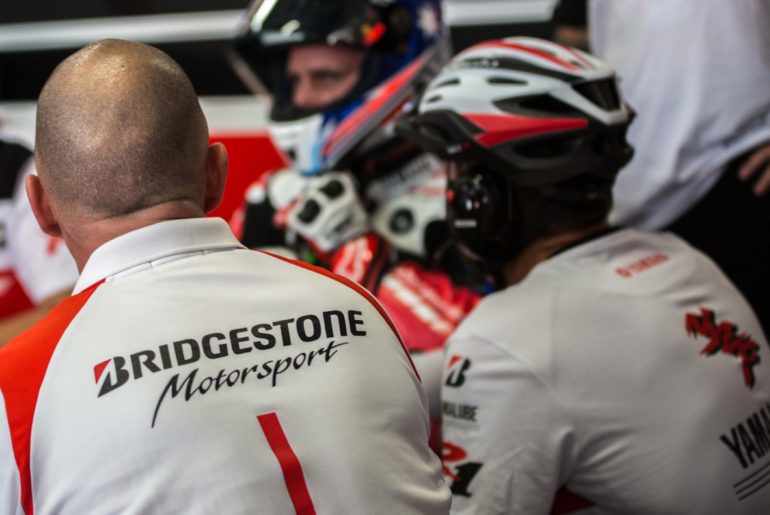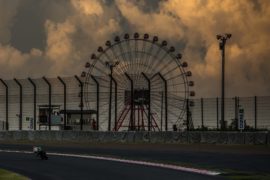What’s the difference between you and me? The Suzuka 8-Hours is dominated by Bridgestone tire. Why is that? And what is the difference between a Bridgestone a Pirelli, and a Michelin at this iconic race?
Even the most talkative factory riders get tight-lipped when the topic of tires is raised. Jonathan Rea was asked after securing pole position for tomorrow’s Suzuka 8-Hours about the feeling he has with Bridgestone tires, compared to using Pirelli rubber in WorldSBK.
The three-time world champion sidestepped that landmine with customary ease by saying, “both are very high performance tires.” It was a similar situation when talking with MotoGP riders about comparing to Michelin tires in recent years. There are, however, some outliers in the paddock.
Riders with experience of Bridgestone, Pirelli, and Michelin tires, and who are able to speak about the contrasts.
Both Michael Laverty and Sylvain Guintoli have plenty of experience on all three brands, with Laverty even acting as a MotoGP test rider at the time when the French manufacturer was building their initial batch of tires for their return to grand prix racing.
Speaking about the contrast between the Bridgestone-shod front-runners at the Suzuka 8-Hours and his Pirelli-tired BMW, the Northern Irishman offered his thoughts on the differences in riding styles.
“The biggest difference is the drop off in lap time with a Pirelli is significant, and in the hotter temperatures here in Suzuka, it’s quite difficult,” said Laverty. “In Europe, the temperature isn’t quite as hot, so you can compete.”
“Here in Japan, it’s so hot and you can hammer a Bridgestone. The harder you work a Bridgestone front tire, the better it performs. You can spin a rear tire for a full 27-lap stint ,and it doesn’t drop off the pace.”
“We have to contend with a big drop off on the Pirelli, and we’re spinning a lot here and at the front, in these temperatures, it’s a good tire, but I know what the Bridgestone is like from MotoGP, and it’s a bit firmer in the heat.”
The fabled Bridgestone front tire, otherwise known as “the one that got away.”
When Michelin first returned to MotoGP, riders lamented the loss of this tire from their lives. The Bridgestone front tire is unlike any other tire. Black and rubber doesn’t describe it at all.
It was very rigid, and kept its position very well. It generated confidence under braking, with a stability that allowed riders to set the corner up as early as possible.
From entering the braking zone, to releasing the brake, it allows riders to be smoother because you don’t feel as much of a transition from one phase to the next of the corner as the bike loads.
“The way in which a Bridgestone steers when the rear is sliding is incredibly impressive,” continued Laverty. “Looking at Dunlop Curve, for example, the Bridgestone riders can spin it up towards the grass, and we’re three metres wider through there.”
“No matter what I do on the bike, I can’t get it to turn to that point on the track. That’s what you can do with a Bridgestone. It’s a different riding style with these tires.”
For Guintoli, the challenge of the different brands of tires was huge in 2017. He was riding full-time in the British Superbike championship on Pirelli tires, with minimal electronics, and his experience of the Italian tire was of little help because the specification of machinery, and because the layouts of tracks were so different.
In addition to this he raced and tested for the Suzuki MotoGP squad on Michelin tyres and rode at Suzuka with his Bridgestone shod Suzuki.
“All three tires are really good, and they’ve all got their own strengths and weaknesses,” said the Frenchman. “You need to get the best out of each of them, and they’re all different for this.”
“Certain tires require certain riding techniques, and of course they all feel different to one another, but also most tires feel different. Even within the same tire brand you can have a different feeling with a different compound or construction of tire.
“Last year was really interesting for me because I rode Pirelli’s in British Superbike, Bridgestone’s for Suzuki at Suzuka, and I also rode Michelin’s in MotoGP.”
“Some of them work better in the cold, some in the hot, so you have a lot to think about when you’re riding. You ride every tire based on the feeling from them, and of course for a pure riding performance, it’s always better to ride only one tire because you can concentrate on how to get the most from it.”
“I think it’s really good to experience such a wide range of tires and regulations – BSB with Pirelli’s and no electronics, WorldSBK with Pirelli and electronics, Bridgestone with an Endurance bik,e and Michelin with a MotoGP bike – they all work differently with the different specification of bike too, so it’s been interesting for me to do this much riding with them.”
The Bridgestone tire used at Suzuka is very similar to what they used in MotoGP in 2015, the Pirelli is similar in feeling to their WorldSBK offering. As of yet it, doesn’t come with the increased profile that riders have made the default WorldSBK tire of late.
The Italian firm is keen to increase their footing in the Endurance World Championship, but understand that breaking the Bridgestone monopoly at the front will be almost impossible.
The experience of the Japanese manufacturers around the Japanese circuit with Japanese tires is simply too much to overcome in the near future.
Photo: © 2018 Steve English – All Rights Reserved
Our Suzuka 8-Hours coverage is made possible by our A&R Pro members. Thank you for supporting it!




